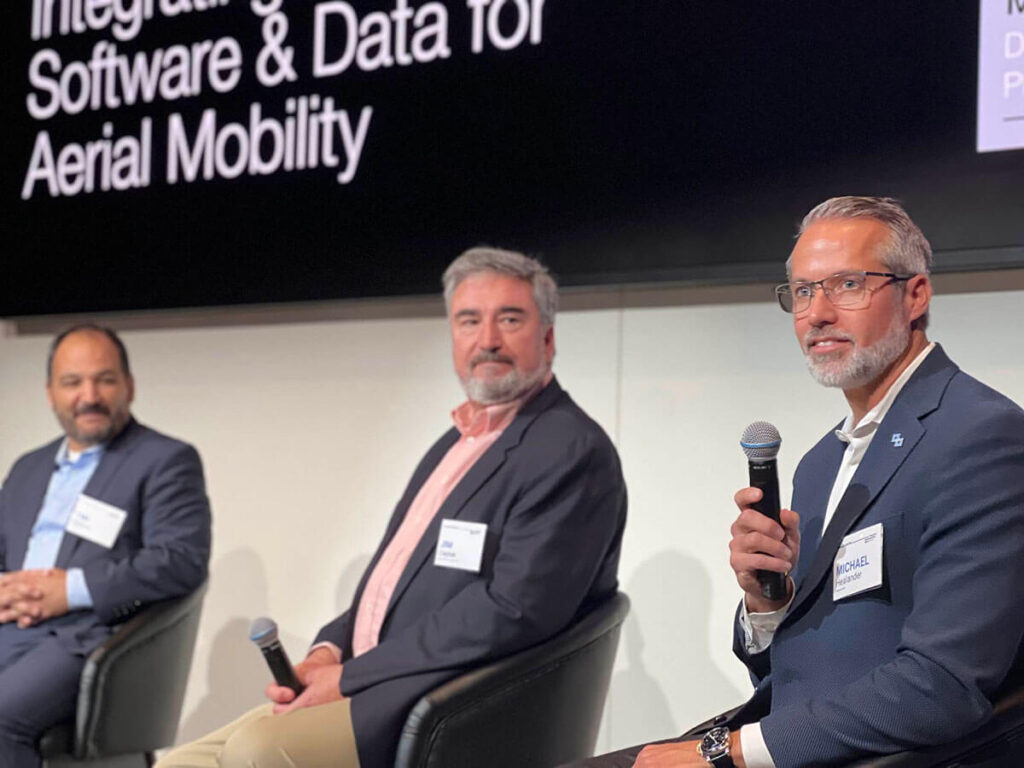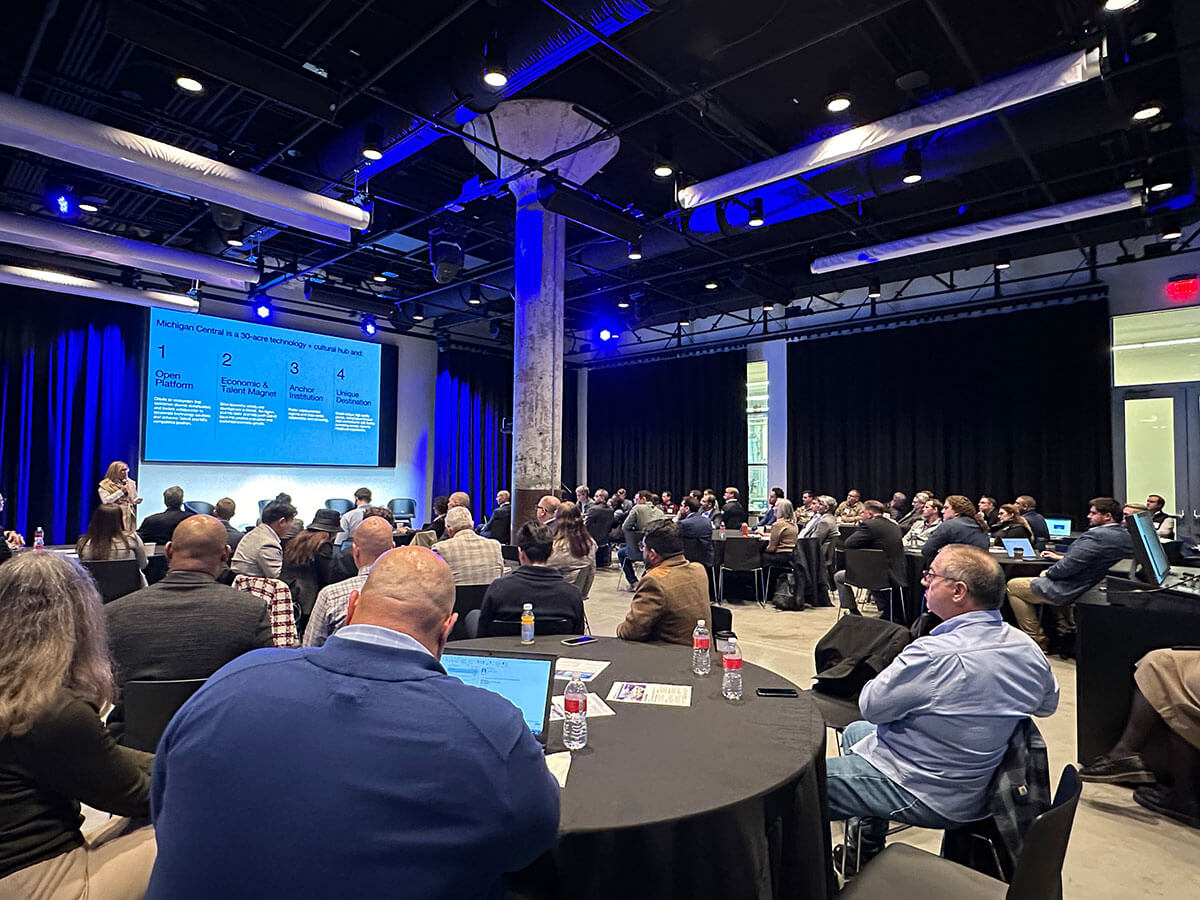In the heart of Motor City, a new era of aviation has started to unfold. Detroit, long known for its automotive innovation, is now positioning itself as a hub for Advanced Air Mobility (AAM). With Michigan’s unique blend of automotive innovation, technological infrastructure and strategic vision, the state aims to transform from an automotive powerhouse to a cutting-edge mobility laboratory.
This article explores how several key organizations—Airspace Link, uAvionix, Accipiter Radar and the Michigan Central Innovation District—are collaborating to create a robust ecosystem that supports the integration of drones, and eventually larger air taxis, into the national airspace. Read on as we delve into the critical components Detroit has blended for successful AAM integration, from funding and physical infrastructure to software, communication and airspace awareness systems.

The Michigan Advantage: Detroit’s Mobility and Innovation Ecosystem
Detroit’s unique blend of urban infrastructure, technological prowess and manufacturing heritage makes it an ideal testbed for AAM. The city’s commitment to innovation seems evident in the collaborative efforts between industry leaders, government agencies and academic institutions.
A Comprehensive Mobility Strategy
Michigan’s strategy for a thriving mobility ecosystem extends beyond traditional automotive mobility to include AAM and drone technology. With ongoing investments in infrastructure, technology and human capital, the city of Detroit, in particular, continues to build on its automotive heritage and embrace the future of mobility to position itself as a global leader in the development and implementation of AAM solutions.
Justine Johnson, Chief Mobility Officer for the state of Michigan, highlighted the state’s comprehensive approach to mobility innovation that includes various state departments. “We’re utilizing clean energy to help move people, goods and information across land, water and air,” Johnson explained. The state created noteworthy mobility programs, such as the Michigan Mobility Pilot platform. This platform has facilitated dialogue between traditional aviation and the future of air mobility.
The Advanced Air Mobility Activation Fund
As further evidence of the state’s commitment to innovation it has, along with Michigan Central, invested millions of dollars into AAM. One key example, the Advanced Air Mobility Activation Fund, a partnership between the Michigan Department of Transportation and the Office of Future Mobility and Electrification, aims to support projects that address real-world problems, particularly in rural areas, by leveraging drone technology for medical supply delivery and other critical services. They do this in the Michigan Central Innovation District, a literal and figurative launchpad for AAM technologies.
The Michigan Central Innovation District: A Living Laboratory
Among other features, the Michigan Central Innovation District includes a three mile radius urban testing ground for AAM so companies can evaluate their operational solutions in real-world scenarios and accelerate the path to commercialization. This summer, Michigan Central celebrated the opening of an Operations Center in the historic Michigan Central Station building. Next on tap: a 14th-floor Air Traffic Control tower. In the meantime, today, real-world drone deliveries have already started taking place as part of pilot programs from the roof of the Newlab, a mobility startup hub located on the Michigan Central innovation campus next door to the future Air Traffic Control tower.
Michael Healander, Co-Founder, President & CEO of Airspace Link, highlighted the district’s significance. “This is a really new opportunity for businesses,” he said. “We’re not just talking about first responders or infrastructure inspections. We’re creating a sustainable business environment where companies can operate and scale with customer demand.”
As the Detroit AAM ecosystem evolves, it continues to attract businesses and innovators from around the world. The Michigan Central Innovation District, with its state-of-the-art facilities and supportive environment, is fast becoming a magnet for companies looking to develop and test their AAM technologies in real-world conditions.

Leveraging Infrastructure for Integration: The Companies Making AAM Happen
In the meantime, a public-private partnership grows in the background to turn these AAM dreams into reality. Airspace Link, uAvionix and Accipiter Radar continue collaborating with the Michigan Central Innovation District to provide the infrastructure backbone necessary to integrate AAM into Detroit’s skies. These industry partners work together to address challenges such as: integrating unmanned aircraft with traditional aviation traffic, developing robust detect-and-avoid systems, ensuring reliable communication links between ground control and drones and mitigating potential conflicts with birds and other airspace users.
Airspace Link: The Connective Tissue
Airspace Link’s AirHub Portal platform serves as the connective tissue for the AAM ecosystem in Detroit and beyond. Through its digital platform AirHub Portal, Airspace Link provides crucial services like B4UFLY and LAANC, while also offering customized solutions such as the community-oriented FlySafe Program. This comprehensive approach enables Airspace Link to equip pilots, municipalities, and local populations with the tools to adopt drone technology with assurance and expand their operations. With an average of 30,000 flight planning efforts per day and thousands of FAA authorizations processed, the company stands at the epicenter of drone integration.
Healander outlined five critical components that Airspace Link literally links together: hardware and infrastructure, software, drone OEMs and operators, governance and policy and business operations. By harmonizing these elements, Airspace Link has created a scalable model that can be replicated across the country.
“We have over 5000 businesses and government agencies on our platform today,” Healander explained. “From small two-person drone operations to major players like the Air Force and UPS, we’re supporting just about every type of operation you can think of right here in Detroit and in other areas. We welcome you to come too.”
uAvionix: Enhancing Communication Infrastructure
Jim Cieplak, a consultant at uAvionix, who brings decades of experience in both manned and unmanned aviation to the Detroit AAM ecosystem, described how uAvionix has developed robust communication systems that enable drones to interact seamlessly with existing air traffic control networks.
The company facilitates advanced operations by offering a diverse array of cutting-edge, lightweight avionics, hardware and support services. It has established a strong presence in general aviation for its avionics solutions, as well as its compact transponders designed for military applications. Building on this foundation of knowledge and experience, uAvoinix has developed a comprehensive suite of products and services tailored to enable sophisticated commercial drone and AAM missions. This ecosystem encompasses everything from flight planning tools to real-time tracking systems.
Cieplak emphasized the importance of leveraging not just new, but also existing, aviation infrastructure to grow the industry. “We need to develop systems that can detect and mitigate risks, drawing on our experience in manned aviation to enhance safety in the AAM industry,” he said. “We also have existing aviation infrastructure that can be used for multiple purposes. We need to use them all.”
Accipiter Radar: Advancing Airspace Awareness
Dr. Tim Nohara, President & CEO of Accipiter Radar, has contributed crucial surveillance and decision support systems to the Detroit AAM ecosystem for years. Accipiter’s technology ensures comprehensive airspace awareness in Detroit by detecting both cooperative and non-cooperative aircraft.
Nohara shared, “We’re focused on the hardware team, which includes the surveillance infrastructure, and the software engineering that helps make sense of the data and provides awareness to the end-users.” He continued, “We actually began with maritime domain awareness many years ago right here in Detroit’s front yard. We deployed our first surveillance networks and our first shared decision support software along the Detroit River, Lake Saint Clair and Saint Clair River. We are excited to be a key component for airspace awareness at Michigan Central.”

The Road Ahead: Scaling Detroit and Beyond
As Detroit’s AAM ecosystem continues to mature, the focus remains on creating practical, scalable solutions that can drive economic growth and improve urban mobility. With Airspace Link coordinating efforts, uAvionix enhancing communication infrastructure, Accipiter Radar ensuring airspace awareness, the state providing funding and programmatic support and the Michigan Central Innovation District providing a real-world testing environment, Detroit is well-positioned to lead the nation in AAM development.
And while Detroit serves as the initial proving ground, the entire team seeks to create a model that can be replicated nationwide. Nohara pointed to the future potential for cross-border applications of drone technology, particularly in the Detroit area. According to Nohara, Accipter’s maritime applications have laid the groundwork for broader drone integration.”A great use case would be a cross border one that involves even using drones to pick up a package from a ship and bring it inland,” he said.
Healander similarly envisions a future where successful operations in Detroit can easily expand to other parts of the state and country. “Our goal isn’t just to say we’re successful in Detroit,” Healander explained. “We want these companies to stay with us and help support the infrastructure to scale their businesses beyond this initial testbed.”
This collaborative spirit, one that has long defined Detroit’s industrial heritage, now propels the city into the forefront of aviation innovation. As these technologies – and partnerships- mature and evolve, the Motor City seems poised to become a model for air mobility integration across the United States.

